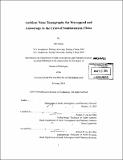Ambient noise tomography for wavespeed and anisotropy in the crust of southwestern China
Author(s)
Huang, Hui, Ph. D. Massachusetts Institute of Technology
DownloadFull printable version (19.12Mb)
Other Contributors
Massachusetts Institute of Technology. Department of Earth, Atmospheric, and Planetary Sciences.
Advisor
Robert D. van der Hilst.
Terms of use
Metadata
Show full item recordAbstract
The primary objective of this thesis is to improve our understanding of the crustal structure and deformation in the southeastern Tibetan Plateau and adjacent regions using surface wave tomography. Green's functions for Rayleigh and Love waves are extracted from ambient noise interferometry. Using the Green's functions, we first conduct traditional traveltime tomography for the two shear wavespeeds Vsv and Vsh Their differences are measured as radial anisotropy. We then conduct Eikonal tomography to study azimuthal anisotropy in the crust. Our tomography results are well consistent with geology in the study region. In the Sichuan Basin, low wavespeed and positive radial anisotropy (Vsh> Vsv) in the upper crust reflect thick sedimentary layers at surface; high wavespeed and small radial anisotropy in the middle and lower crust reflect a cold and rigid basin root. Little azimuthal anisotropy is observed in the Basin, indicating small internal deformation. In the Tibetan Plateau, we observe widespread low wavespeed zones with positive anisotropy in the middle and lower crust, which may reflect combined effects of weakened rock mechanism and horizontal flow in the deep crust of southeastern Tibet. The northern part of the Central Yunnan block, which geographically coincides with the inner zone of the Emeishan flood basalt, reveals relatively higher wavespeeds than the surrounding regions and little radial anisotropy throughout the entire crust. We speculate that the high wavespeeds and small radial anisotropy are due to combined effects of the remnants of intruded material from mantle with sub-vertical structures and channel flow with sub-horizontal structures. In general, the azimuthal anisotropy in our study region is consistent with a clockwise rotation around the Eastern Himalayan Syntaxis. Careful examination reveals large angular differences between the azimuthal anisotropy in the upper and lower crust, suggesting different deformation patterns at the surface and in depth. Therefore, our tomography results support models with ductile flow in the deep crust of the southeastern Tibetan Plateau; however, the large lateral variation of both wavespeeds and anisotropy indicates that the flow also varies greatly in intensity and pattern in different geological units.
Description
Thesis: Ph. D., Massachusetts Institute of Technology, Department of Earth, Atmospheric, and Planetary Sciences, 2014. Cataloged from PDF version of thesis. Includes bibliographical references.
Date issued
2014Department
Massachusetts Institute of Technology. Department of Earth, Atmospheric, and Planetary SciencesPublisher
Massachusetts Institute of Technology
Keywords
Earth, Atmospheric, and Planetary Sciences.